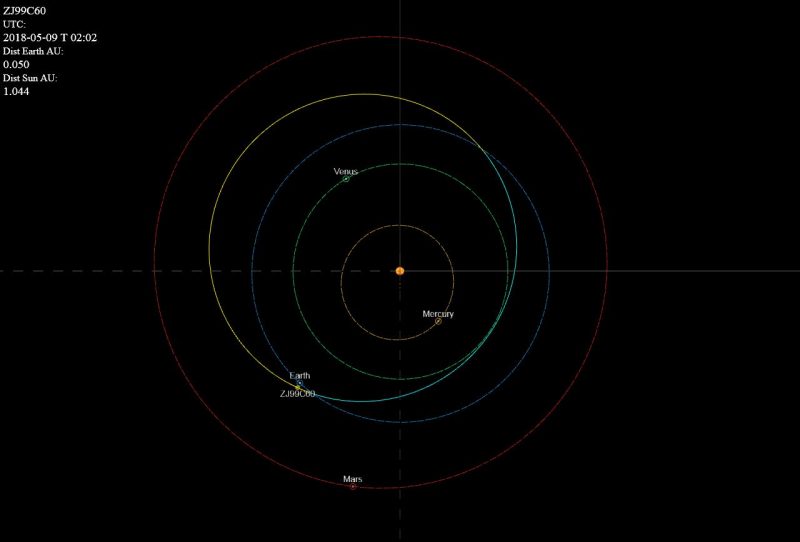
Orbit of asteroid 2010 WC9 (formerly called ZJ99C60) via Asteroid Orbit View and Northolt Branch Observatories.
Posted on 05/12/2018 8:06:33 PM PDT by BenLurkin
Asteroid 2010 WC9 will safely pass at about half’s the moon’s distance on Tuesday, May 15, 2018. Estimates of its size range from 197 to 427 feet (60-130 meters), making the May 15 pass one of the closest approaches ever observed of an asteroid of this size. This asteroid was “lost” and then found again. The Catalina Sky Survey in Arizona first detected it on November 30, 2010, and astronomers watched it until December 1, when it became too faint to see. They didn’t have enough observations to track its orbit fully and so predict its return. On May 8, 2018 – almost eight years later – astronomers discovered an asteroid and gave it the temporary designation ZJ99C60. Then they realized it was asteroid 2010 WC9, returning.
During the 2018 return, closest approach of asteroid 2010 WC9 will happen on May 15 at 22:05 UTC (6:05 pm EDT; translate to your time). At that time, the asteroid will be 0.53 lunar-distances from Earth (126,419 miles or 203,453 km from Earth). According to orbit calculations made by NASA’s Jet Propulsion Laboratory, the May 15 close approach is the closest of this particular asteroid in nearly 300 years.
Is this a large asteroid? No... But it is larger than the estimated size of the Chelyabinsk meteor, which entered Earth’s atmosphere, breaking windows in six Russian cities and causing some 1,500 people to seek medical attention, in 2013....
Asteroid 2010 WC9 is an Apollo type space rock. At no time will it be visible to the eye as it sweeps past Earth. It might get as bright as magnitude +11, which would make it bright enough to be seen in amateur telescopes pointed at the correct location and time.
Asteroid 2010 WC9 is travelling...28,655 miles per hour (46,116 km/h).
(Excerpt) Read more at earthsky.org ...

478 miles per second...Is that about average for a space rock?
You need to divide by 60 again.
It’s going about 8 miles per second. That must be relative to earth because the earth is doing about 18.6 miles per second around the sun.

Yep, error. I posted instead per minute.
About right for me.
I did not realize mercury had such an eccentric orbit. So, how far into the future can we predict 6 body gravitational problems?
It’s more like 8 miles per second. Totally typical given the eccentricity of the orbit.
Dang, that is close!
*The old mutt lives for chasing critters that want his food.
The general n-body problem has no closed-form solution, and the farther out you go with a numerical approximation, the harder it gets.
I don’t know how far is used in practice.
Thanks BenLurkin. One of these "lost" objects" could give us the old "honey, I'm home" moment. Kinda exciting, I've got no long range plans.
|
Looking at the schematic of the orbits of the asteroid and Earth it looks like it WILL eventually hit one day unless it hits something else first
It's matter of hitting a spinning ball at a particular spot with a projectile, but this kind of problem is what computers are for.
For any given combination of mass, density and relative speed, it's possible to calculate blast and thermal effects with reasonable reliability.
If at first you don’t succeed, try again.
These rocks are getting closer and closer.
“...28,655 miles per hour...”
Hell, my ‘73 TR6 went faster than that. (Heh).
:”)
Any final word on the fly by?
Disclaimer: Opinions posted on Free Republic are those of the individual posters and do not necessarily represent the opinion of Free Republic or its management. All materials posted herein are protected by copyright law and the exemption for fair use of copyrighted works.